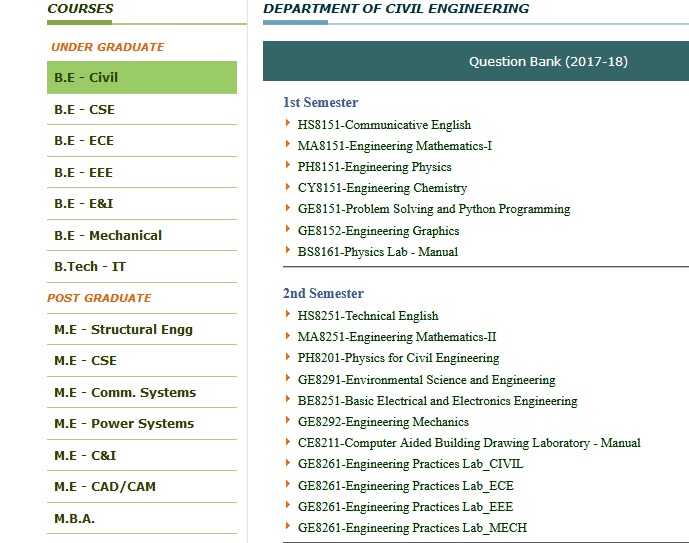CU7007 Internetworking Multimedia M.E Question Bank : valliammai.co.in
Name of the College : Valliammai Engineering College
University : Anna University
Department : Electronics and Communication Engineering
Subject Code/Name : CU7007-Internetworking Multimedia
Degree : M.E Communication Systems
Year : II
Semester : III
Document Type : Question Bank
Website : valliammai.co.in
Download : https://www.pdfquestion.in/uploads/va…Multimedia.pdf
Valliammai Internetworking Multimedia Question Paper
Unit – I
Multimedia Networking :
Part A :
1. List any 4 characteristics of multimedia elements.
2. What is the need of internetworking?
3. Draw the internet multimedia protocol stack.
Related : Valliammai Engineering College NE7007 Network Management M.E Question Bank : www.pdfquestion.in/2793.html
4. Compare scalar quantization and vector quantization.
5. Differentiate symmetrical and asymmetrical compression techniques.
6. Give some basic sound editing operation.
7. What is MIDI and what are necessary for creating a MIDI?
8. Give the advantages and disadvantages of MIDI.
9. What is a Codec?
10.Why do we go for Digital Video Compression?

11. What are the factors to be considered for making digital audio?
12. Define Bitmap and its uses.
13.List the profiles and levels of MPEG 2.
14. Define sub-band coding algorithm.
15. Define Dithering.
16. What is Huffman compression?
17.Compare composite analog video and component analog video
18. What is H.261?
19.List some basic enhancements in H.263
20. Which component of multimedia needs highest compression? Why?
Part B :
1) Explain the process of encoding algorithm :Moving images using H.261
2) Explain the various internet service models in detail.
3) Explain dictionary approaches to compression with an example.
4) Discuss on multimedia communication in wireless network.
5) Write short notes on digital audio
6) Write short notes on digital video and MIDI
7) Explain H.261 compression technique in detail.
8) Define MPEG. Explain how MPEG is used for video compression?
9) Compare various compression techniques applied to video element of multimedia.
10)Discuss the architecture and network requirements for audio/video transmission
11)Write short note on multimedia networking
12) Explain in detail the compression method used for text, audio and video.
Unit – II
Broadband Network Technology :
Part A :
1. Name 2 hybrid approaches to build a fast internet.
2. Define the throughput and delay.
3. What are the various factors that affect synchronization?
4. What is traffic shaping?
5. Define IPV6. What are the two unique design features of IPV6?
6. How is the performance of multimedia networks evaluated?
7. What are the advantages of IPV6 over IPV4?
8. Draw the basic IPV6 protocol stack.
9. What are broadband services?
10.What is meant by buffer management?
11. Define jitter and throughput.
12. What do you mean by jitter performance metrics?
13. Define ATM. List out the main features of ATM.
14. Give the characteristics of ATM networks.
15.What are the objectives of resource reservation?
16.What are the client scheduling issues?
17. Define near video on demand systems.
18.What are the elements present in index?
19. Define CODEC. What is the need of it?
20. Describe the objectives of recording and playback system.
Part B :
1) What are the drawbacks of existing IP? Discuss IPV6 protocol in detail.
2) Discuss concepts in high speed switching.
3) Explain the buffer management techniques used in high speed networks.
4) Explain scheduling and policing in ATM.
5) How does resource reservation handled in ATM networks.
6) Write short notes on Traffic shaping.
7) Explain the simpler model of service differentiation based on network pricing theory.
8) Explain in detail about Voice and video over IP.
9) Describe about MPEG-2 over ATM in detail.
10) Describe the storage and media services used in broadband networks.
11) Describe in detail about recording and remote server.
12) Explain the various indexing of synchronization techniques.
Unit – III
Reliable Transport Protocol And Applications :
Part – A :
1. How will you build a multicast tree in center-based tree protocol?
2. What are the payloads defined for RTP?
3. How Multicast Scoping is performed?
4. What is multicasting? Write two traditional methods used in multicast?
5. What is meant by call-set-up protocol?
6. Summaries the IP multicast service model
7. Define TTL scoping.
8. What is Administrative scoping?
9. What is reliable multicast?
10.What is meant by Fate sharing?
11.What is TCP adaption algorithm?
12.What are the purposes for adaption to delay at the receiver?
13.What is the use of RTCP?
14. Define Peer to Peer computing? Mention the unique characteristics of Peer to Peer
15.Compare Multicast and shared media.
16.What is meant by Video conferencing? What is the important aspects of video conferencing
17.What is MIME?
18.Write MIME header format?
19.What is NBMA network?
20. What is light weight session philosophy?
Part B :
1) Discuss on reliable multicast transport protocols in detail.
2) Explain RTP packet format, header compression in detail.
3) Distinguish between centralized and distributed conference control.
4) How is the multicast backbone useful for multiparty multimedia conferencing experimentation? Explain
5) Explain in detail about multicast routing addressing
6) Write short notes on NBMA networks and MIME.
7) Explain TCP adaptation algorithm. How does it differ from basic TCP?
8) Explain in detail about video conferencing. Mention its applications
9) Explain in detail about RTP and RTCP.
10)Write short notes on (i) Peer to Peer computing and (ii) MIME.
11)Explain in detail about Centralized and distributed conference control
12)Write short notes on light weight session philosophy and distributed virtual reality